Business Law Assignment: Compliance, Anti-Fraud, and Training Plan
VerifiedAdded on 2022/09/22
|12
|2989
|25
Report
AI Summary
This business law assignment examines the role of compliance functions in financial institutions, specifically within the context of an Australian banking organization. It explores the responsibilities of compliance teams, directors, senior managers, employees, and business units in ensuring adherence to regulations. The report analyzes the benefits and positive impacts of a strong compliance function, including risk mitigation and the maintenance of customer trust. Furthermore, the assignment addresses anti-fraud systems within a financial institution, proposing a guidance paper and a detailed training plan to address identified shortcomings. The guidance paper outlines steps to minimize fraud, including supervision, review, audit agencies, and investigations. The training plan emphasizes the importance of employee education to enhance the effectiveness of anti-fraud measures and promote a culture of compliance within the organization. The assignment provides recommendations for improving fraud detection and prevention, highlighting the significance of KYC, case management, and the use of artificial intelligence.
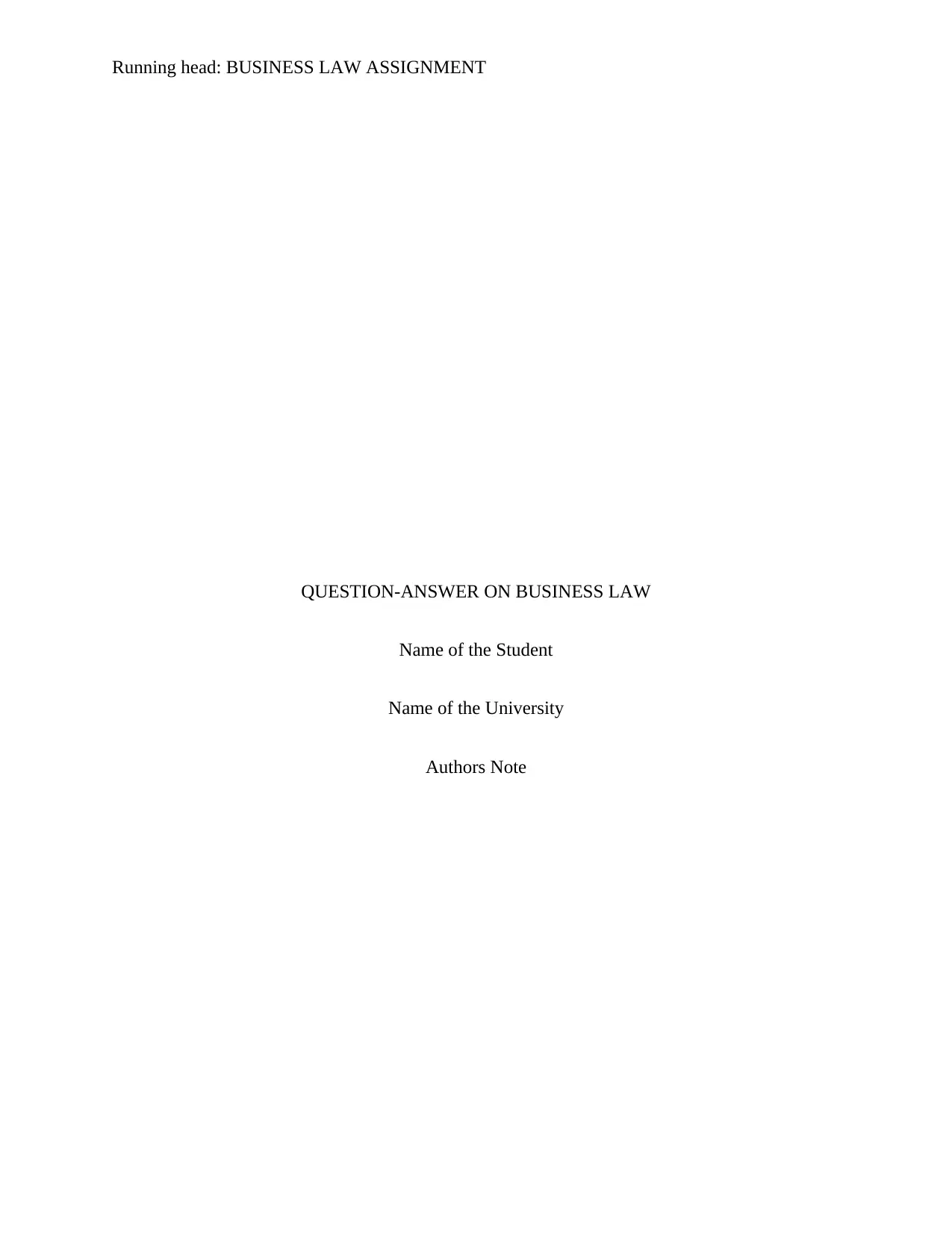
Running head: BUSINESS LAW ASSIGNMENT
QUESTION-ANSWER ON BUSINESS LAW
Name of the Student
Name of the University
Authors Note
QUESTION-ANSWER ON BUSINESS LAW
Name of the Student
Name of the University
Authors Note
Paraphrase This Document
Need a fresh take? Get an instant paraphrase of this document with our AI Paraphraser
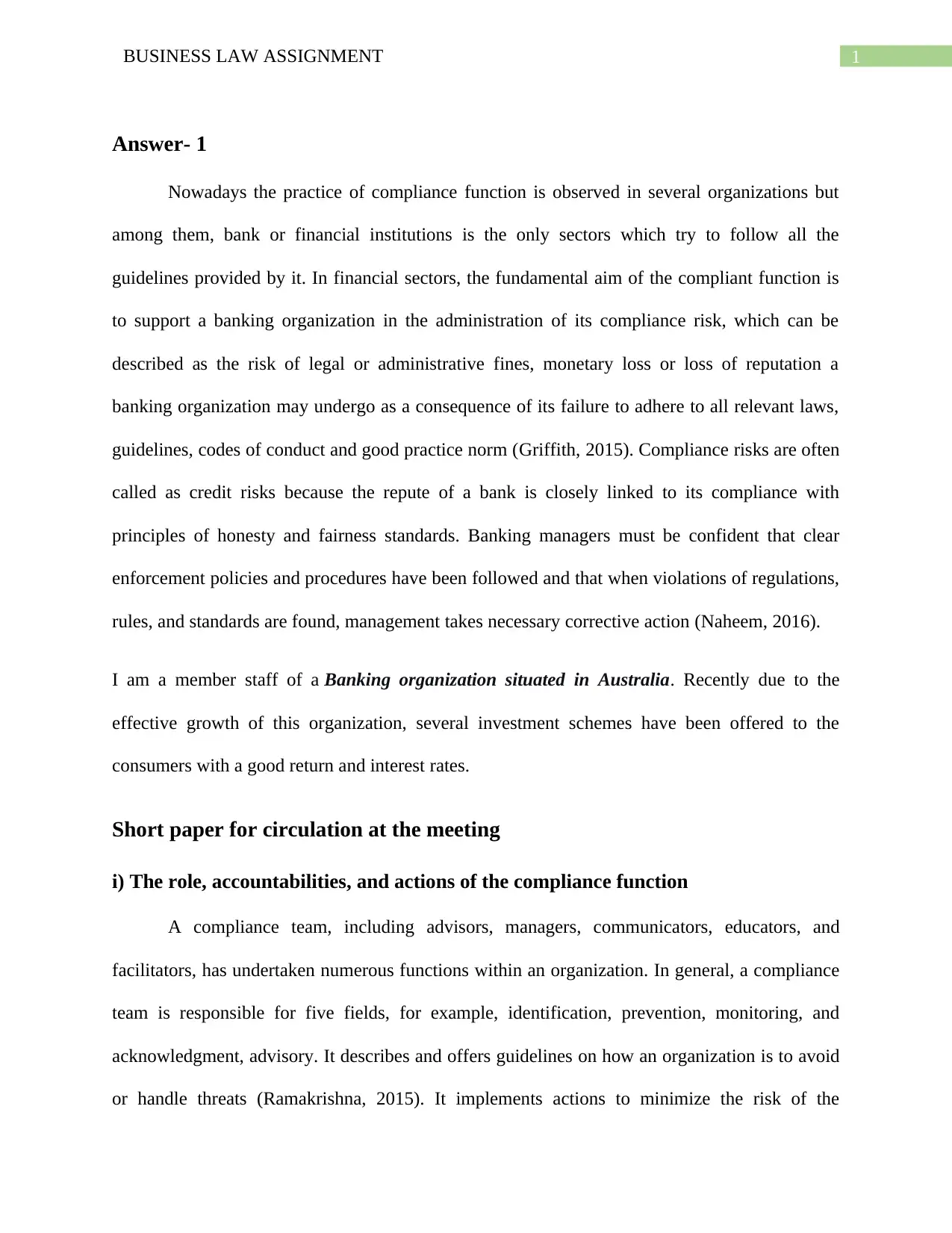
1BUSINESS LAW ASSIGNMENT
Answer- 1
Nowadays the practice of compliance function is observed in several organizations but
among them, bank or financial institutions is the only sectors which try to follow all the
guidelines provided by it. In financial sectors, the fundamental aim of the compliant function is
to support a banking organization in the administration of its compliance risk, which can be
described as the risk of legal or administrative fines, monetary loss or loss of reputation a
banking organization may undergo as a consequence of its failure to adhere to all relevant laws,
guidelines, codes of conduct and good practice norm (Griffith, 2015). Compliance risks are often
called as credit risks because the repute of a bank is closely linked to its compliance with
principles of honesty and fairness standards. Banking managers must be confident that clear
enforcement policies and procedures have been followed and that when violations of regulations,
rules, and standards are found, management takes necessary corrective action (Naheem, 2016).
I am a member staff of a Banking organization situated in Australia. Recently due to the
effective growth of this organization, several investment schemes have been offered to the
consumers with a good return and interest rates.
Short paper for circulation at the meeting
i) The role, accountabilities, and actions of the compliance function
A compliance team, including advisors, managers, communicators, educators, and
facilitators, has undertaken numerous functions within an organization. In general, a compliance
team is responsible for five fields, for example, identification, prevention, monitoring, and
acknowledgment, advisory. It describes and offers guidelines on how an organization is to avoid
or handle threats (Ramakrishna, 2015). It implements actions to minimize the risk of the
Answer- 1
Nowadays the practice of compliance function is observed in several organizations but
among them, bank or financial institutions is the only sectors which try to follow all the
guidelines provided by it. In financial sectors, the fundamental aim of the compliant function is
to support a banking organization in the administration of its compliance risk, which can be
described as the risk of legal or administrative fines, monetary loss or loss of reputation a
banking organization may undergo as a consequence of its failure to adhere to all relevant laws,
guidelines, codes of conduct and good practice norm (Griffith, 2015). Compliance risks are often
called as credit risks because the repute of a bank is closely linked to its compliance with
principles of honesty and fairness standards. Banking managers must be confident that clear
enforcement policies and procedures have been followed and that when violations of regulations,
rules, and standards are found, management takes necessary corrective action (Naheem, 2016).
I am a member staff of a Banking organization situated in Australia. Recently due to the
effective growth of this organization, several investment schemes have been offered to the
consumers with a good return and interest rates.
Short paper for circulation at the meeting
i) The role, accountabilities, and actions of the compliance function
A compliance team, including advisors, managers, communicators, educators, and
facilitators, has undertaken numerous functions within an organization. In general, a compliance
team is responsible for five fields, for example, identification, prevention, monitoring, and
acknowledgment, advisory. It describes and offers guidelines on how an organization is to avoid
or handle threats (Ramakrishna, 2015). It implements actions to minimize the risk of the
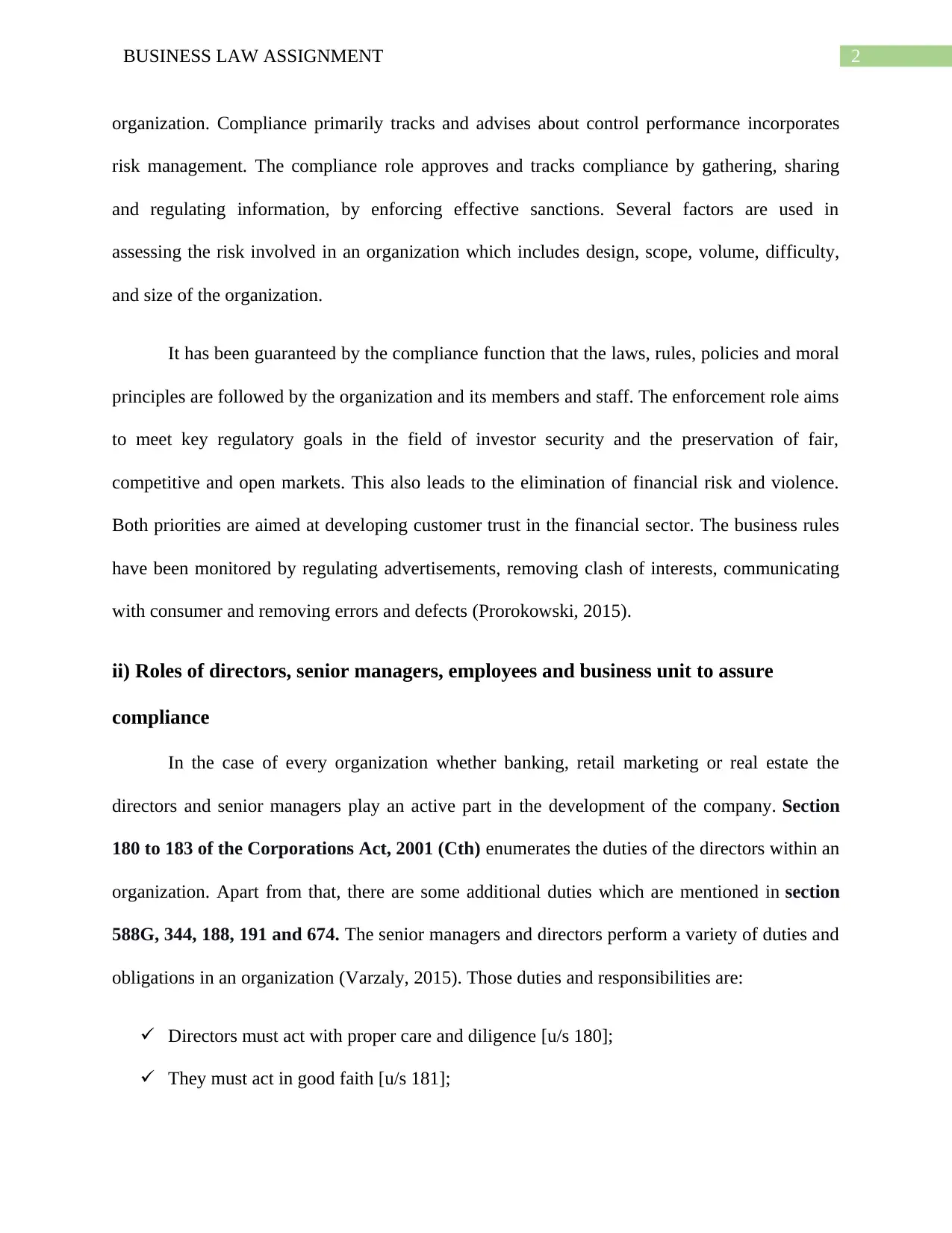
2BUSINESS LAW ASSIGNMENT
organization. Compliance primarily tracks and advises about control performance incorporates
risk management. The compliance role approves and tracks compliance by gathering, sharing
and regulating information, by enforcing effective sanctions. Several factors are used in
assessing the risk involved in an organization which includes design, scope, volume, difficulty,
and size of the organization.
It has been guaranteed by the compliance function that the laws, rules, policies and moral
principles are followed by the organization and its members and staff. The enforcement role aims
to meet key regulatory goals in the field of investor security and the preservation of fair,
competitive and open markets. This also leads to the elimination of financial risk and violence.
Both priorities are aimed at developing customer trust in the financial sector. The business rules
have been monitored by regulating advertisements, removing clash of interests, communicating
with consumer and removing errors and defects (Prorokowski, 2015).
ii) Roles of directors, senior managers, employees and business unit to assure
compliance
In the case of every organization whether banking, retail marketing or real estate the
directors and senior managers play an active part in the development of the company. Section
180 to 183 of the Corporations Act, 2001 (Cth) enumerates the duties of the directors within an
organization. Apart from that, there are some additional duties which are mentioned in section
588G, 344, 188, 191 and 674. The senior managers and directors perform a variety of duties and
obligations in an organization (Varzaly, 2015). Those duties and responsibilities are:
Directors must act with proper care and diligence [u/s 180];
They must act in good faith [u/s 181];
organization. Compliance primarily tracks and advises about control performance incorporates
risk management. The compliance role approves and tracks compliance by gathering, sharing
and regulating information, by enforcing effective sanctions. Several factors are used in
assessing the risk involved in an organization which includes design, scope, volume, difficulty,
and size of the organization.
It has been guaranteed by the compliance function that the laws, rules, policies and moral
principles are followed by the organization and its members and staff. The enforcement role aims
to meet key regulatory goals in the field of investor security and the preservation of fair,
competitive and open markets. This also leads to the elimination of financial risk and violence.
Both priorities are aimed at developing customer trust in the financial sector. The business rules
have been monitored by regulating advertisements, removing clash of interests, communicating
with consumer and removing errors and defects (Prorokowski, 2015).
ii) Roles of directors, senior managers, employees and business unit to assure
compliance
In the case of every organization whether banking, retail marketing or real estate the
directors and senior managers play an active part in the development of the company. Section
180 to 183 of the Corporations Act, 2001 (Cth) enumerates the duties of the directors within an
organization. Apart from that, there are some additional duties which are mentioned in section
588G, 344, 188, 191 and 674. The senior managers and directors perform a variety of duties and
obligations in an organization (Varzaly, 2015). Those duties and responsibilities are:
Directors must act with proper care and diligence [u/s 180];
They must act in good faith [u/s 181];
⊘ This is a preview!⊘
Do you want full access?
Subscribe today to unlock all pages.

Trusted by 1+ million students worldwide
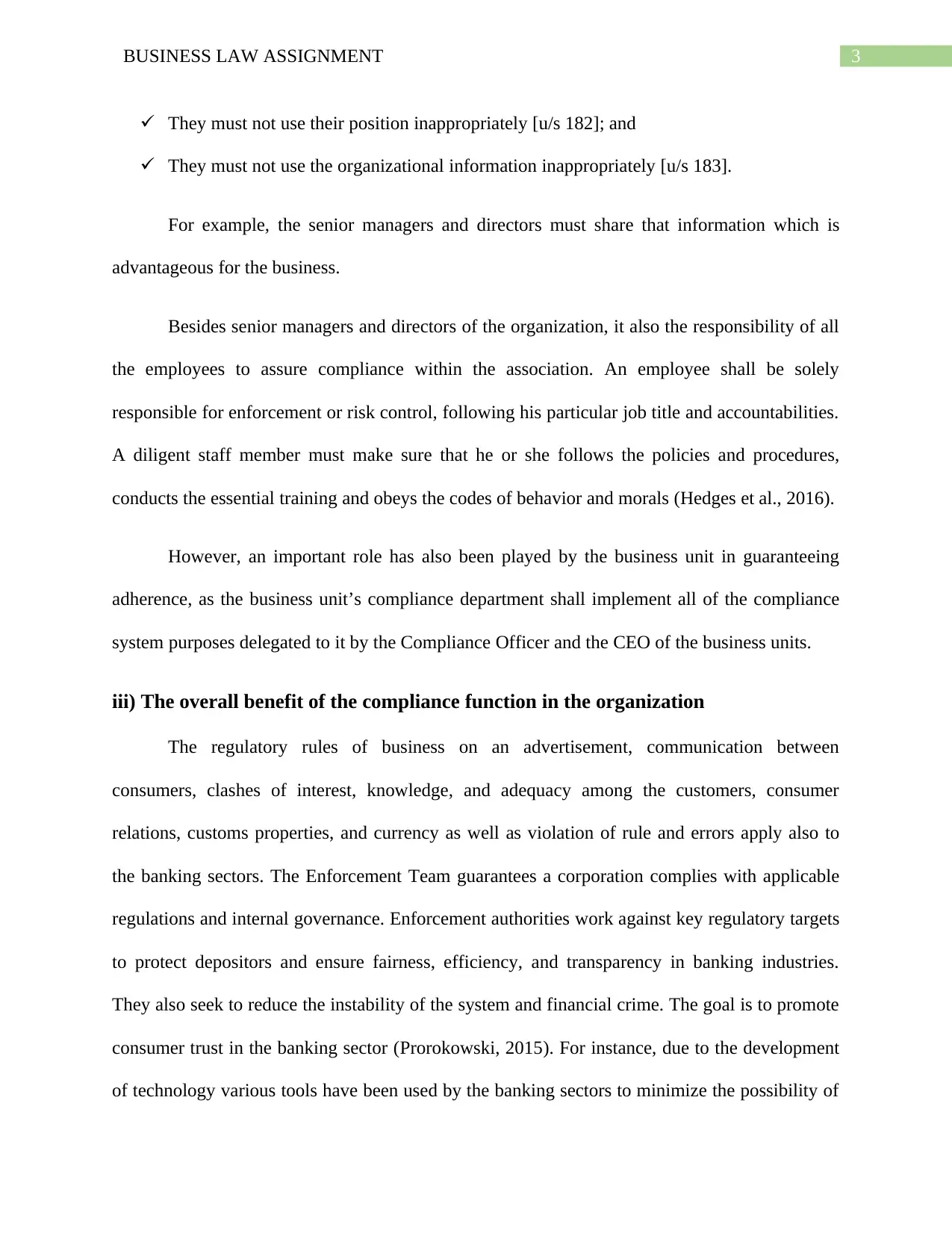
3BUSINESS LAW ASSIGNMENT
They must not use their position inappropriately [u/s 182]; and
They must not use the organizational information inappropriately [u/s 183].
For example, the senior managers and directors must share that information which is
advantageous for the business.
Besides senior managers and directors of the organization, it also the responsibility of all
the employees to assure compliance within the association. An employee shall be solely
responsible for enforcement or risk control, following his particular job title and accountabilities.
A diligent staff member must make sure that he or she follows the policies and procedures,
conducts the essential training and obeys the codes of behavior and morals (Hedges et al., 2016).
However, an important role has also been played by the business unit in guaranteeing
adherence, as the business unit’s compliance department shall implement all of the compliance
system purposes delegated to it by the Compliance Officer and the CEO of the business units.
iii) The overall benefit of the compliance function in the organization
The regulatory rules of business on an advertisement, communication between
consumers, clashes of interest, knowledge, and adequacy among the customers, consumer
relations, customs properties, and currency as well as violation of rule and errors apply also to
the banking sectors. The Enforcement Team guarantees a corporation complies with applicable
regulations and internal governance. Enforcement authorities work against key regulatory targets
to protect depositors and ensure fairness, efficiency, and transparency in banking industries.
They also seek to reduce the instability of the system and financial crime. The goal is to promote
consumer trust in the banking sector (Prorokowski, 2015). For instance, due to the development
of technology various tools have been used by the banking sectors to minimize the possibility of
They must not use their position inappropriately [u/s 182]; and
They must not use the organizational information inappropriately [u/s 183].
For example, the senior managers and directors must share that information which is
advantageous for the business.
Besides senior managers and directors of the organization, it also the responsibility of all
the employees to assure compliance within the association. An employee shall be solely
responsible for enforcement or risk control, following his particular job title and accountabilities.
A diligent staff member must make sure that he or she follows the policies and procedures,
conducts the essential training and obeys the codes of behavior and morals (Hedges et al., 2016).
However, an important role has also been played by the business unit in guaranteeing
adherence, as the business unit’s compliance department shall implement all of the compliance
system purposes delegated to it by the Compliance Officer and the CEO of the business units.
iii) The overall benefit of the compliance function in the organization
The regulatory rules of business on an advertisement, communication between
consumers, clashes of interest, knowledge, and adequacy among the customers, consumer
relations, customs properties, and currency as well as violation of rule and errors apply also to
the banking sectors. The Enforcement Team guarantees a corporation complies with applicable
regulations and internal governance. Enforcement authorities work against key regulatory targets
to protect depositors and ensure fairness, efficiency, and transparency in banking industries.
They also seek to reduce the instability of the system and financial crime. The goal is to promote
consumer trust in the banking sector (Prorokowski, 2015). For instance, due to the development
of technology various tools have been used by the banking sectors to minimize the possibility of
Paraphrase This Document
Need a fresh take? Get an instant paraphrase of this document with our AI Paraphraser
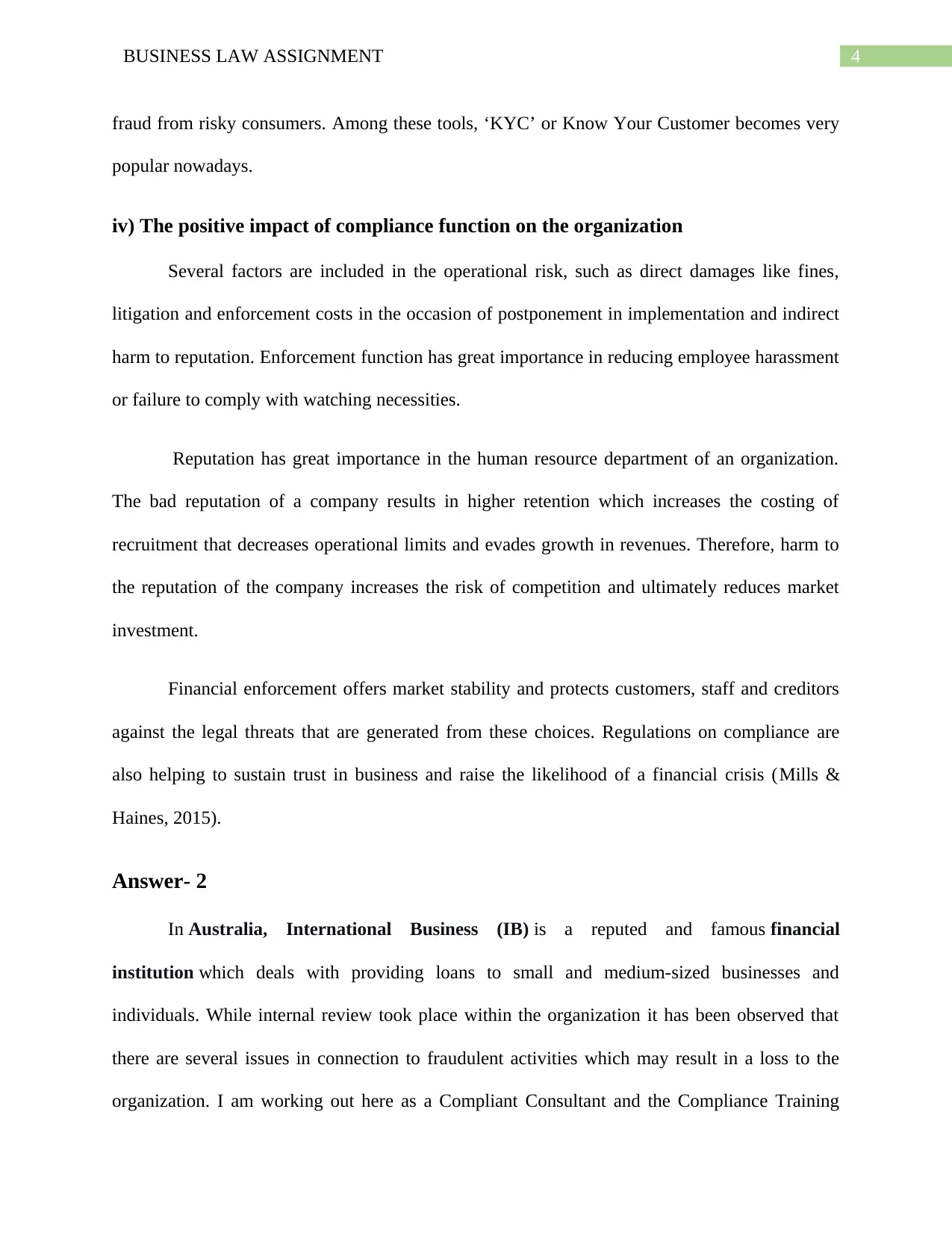
4BUSINESS LAW ASSIGNMENT
fraud from risky consumers. Among these tools, ‘KYC’ or Know Your Customer becomes very
popular nowadays.
iv) The positive impact of compliance function on the organization
Several factors are included in the operational risk, such as direct damages like fines,
litigation and enforcement costs in the occasion of postponement in implementation and indirect
harm to reputation. Enforcement function has great importance in reducing employee harassment
or failure to comply with watching necessities.
Reputation has great importance in the human resource department of an organization.
The bad reputation of a company results in higher retention which increases the costing of
recruitment that decreases operational limits and evades growth in revenues. Therefore, harm to
the reputation of the company increases the risk of competition and ultimately reduces market
investment.
Financial enforcement offers market stability and protects customers, staff and creditors
against the legal threats that are generated from these choices. Regulations on compliance are
also helping to sustain trust in business and raise the likelihood of a financial crisis (Mills &
Haines, 2015).
Answer- 2
In Australia, International Business (IB) is a reputed and famous financial
institution which deals with providing loans to small and medium-sized businesses and
individuals. While internal review took place within the organization it has been observed that
there are several issues in connection to fraudulent activities which may result in a loss to the
organization. I am working out here as a Compliant Consultant and the Compliance Training
fraud from risky consumers. Among these tools, ‘KYC’ or Know Your Customer becomes very
popular nowadays.
iv) The positive impact of compliance function on the organization
Several factors are included in the operational risk, such as direct damages like fines,
litigation and enforcement costs in the occasion of postponement in implementation and indirect
harm to reputation. Enforcement function has great importance in reducing employee harassment
or failure to comply with watching necessities.
Reputation has great importance in the human resource department of an organization.
The bad reputation of a company results in higher retention which increases the costing of
recruitment that decreases operational limits and evades growth in revenues. Therefore, harm to
the reputation of the company increases the risk of competition and ultimately reduces market
investment.
Financial enforcement offers market stability and protects customers, staff and creditors
against the legal threats that are generated from these choices. Regulations on compliance are
also helping to sustain trust in business and raise the likelihood of a financial crisis (Mills &
Haines, 2015).
Answer- 2
In Australia, International Business (IB) is a reputed and famous financial
institution which deals with providing loans to small and medium-sized businesses and
individuals. While internal review took place within the organization it has been observed that
there are several issues in connection to fraudulent activities which may result in a loss to the
organization. I am working out here as a Compliant Consultant and the Compliance Training
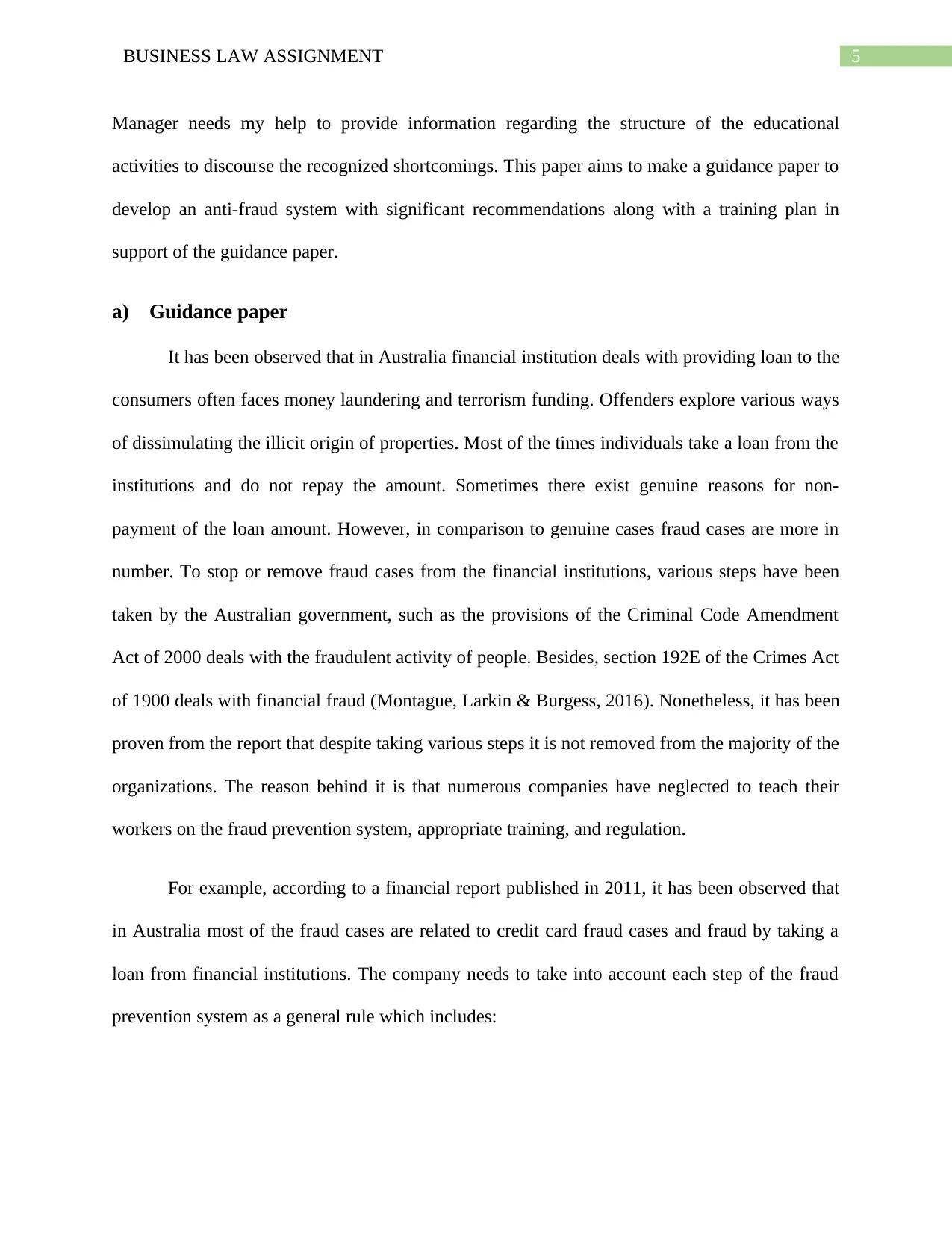
5BUSINESS LAW ASSIGNMENT
Manager needs my help to provide information regarding the structure of the educational
activities to discourse the recognized shortcomings. This paper aims to make a guidance paper to
develop an anti-fraud system with significant recommendations along with a training plan in
support of the guidance paper.
a) Guidance paper
It has been observed that in Australia financial institution deals with providing loan to the
consumers often faces money laundering and terrorism funding. Offenders explore various ways
of dissimulating the illicit origin of properties. Most of the times individuals take a loan from the
institutions and do not repay the amount. Sometimes there exist genuine reasons for non-
payment of the loan amount. However, in comparison to genuine cases fraud cases are more in
number. To stop or remove fraud cases from the financial institutions, various steps have been
taken by the Australian government, such as the provisions of the Criminal Code Amendment
Act of 2000 deals with the fraudulent activity of people. Besides, section 192E of the Crimes Act
of 1900 deals with financial fraud (Montague, Larkin & Burgess, 2016). Nonetheless, it has been
proven from the report that despite taking various steps it is not removed from the majority of the
organizations. The reason behind it is that numerous companies have neglected to teach their
workers on the fraud prevention system, appropriate training, and regulation.
For example, according to a financial report published in 2011, it has been observed that
in Australia most of the fraud cases are related to credit card fraud cases and fraud by taking a
loan from financial institutions. The company needs to take into account each step of the fraud
prevention system as a general rule which includes:
Manager needs my help to provide information regarding the structure of the educational
activities to discourse the recognized shortcomings. This paper aims to make a guidance paper to
develop an anti-fraud system with significant recommendations along with a training plan in
support of the guidance paper.
a) Guidance paper
It has been observed that in Australia financial institution deals with providing loan to the
consumers often faces money laundering and terrorism funding. Offenders explore various ways
of dissimulating the illicit origin of properties. Most of the times individuals take a loan from the
institutions and do not repay the amount. Sometimes there exist genuine reasons for non-
payment of the loan amount. However, in comparison to genuine cases fraud cases are more in
number. To stop or remove fraud cases from the financial institutions, various steps have been
taken by the Australian government, such as the provisions of the Criminal Code Amendment
Act of 2000 deals with the fraudulent activity of people. Besides, section 192E of the Crimes Act
of 1900 deals with financial fraud (Montague, Larkin & Burgess, 2016). Nonetheless, it has been
proven from the report that despite taking various steps it is not removed from the majority of the
organizations. The reason behind it is that numerous companies have neglected to teach their
workers on the fraud prevention system, appropriate training, and regulation.
For example, according to a financial report published in 2011, it has been observed that
in Australia most of the fraud cases are related to credit card fraud cases and fraud by taking a
loan from financial institutions. The company needs to take into account each step of the fraud
prevention system as a general rule which includes:
⊘ This is a preview!⊘
Do you want full access?
Subscribe today to unlock all pages.

Trusted by 1+ million students worldwide
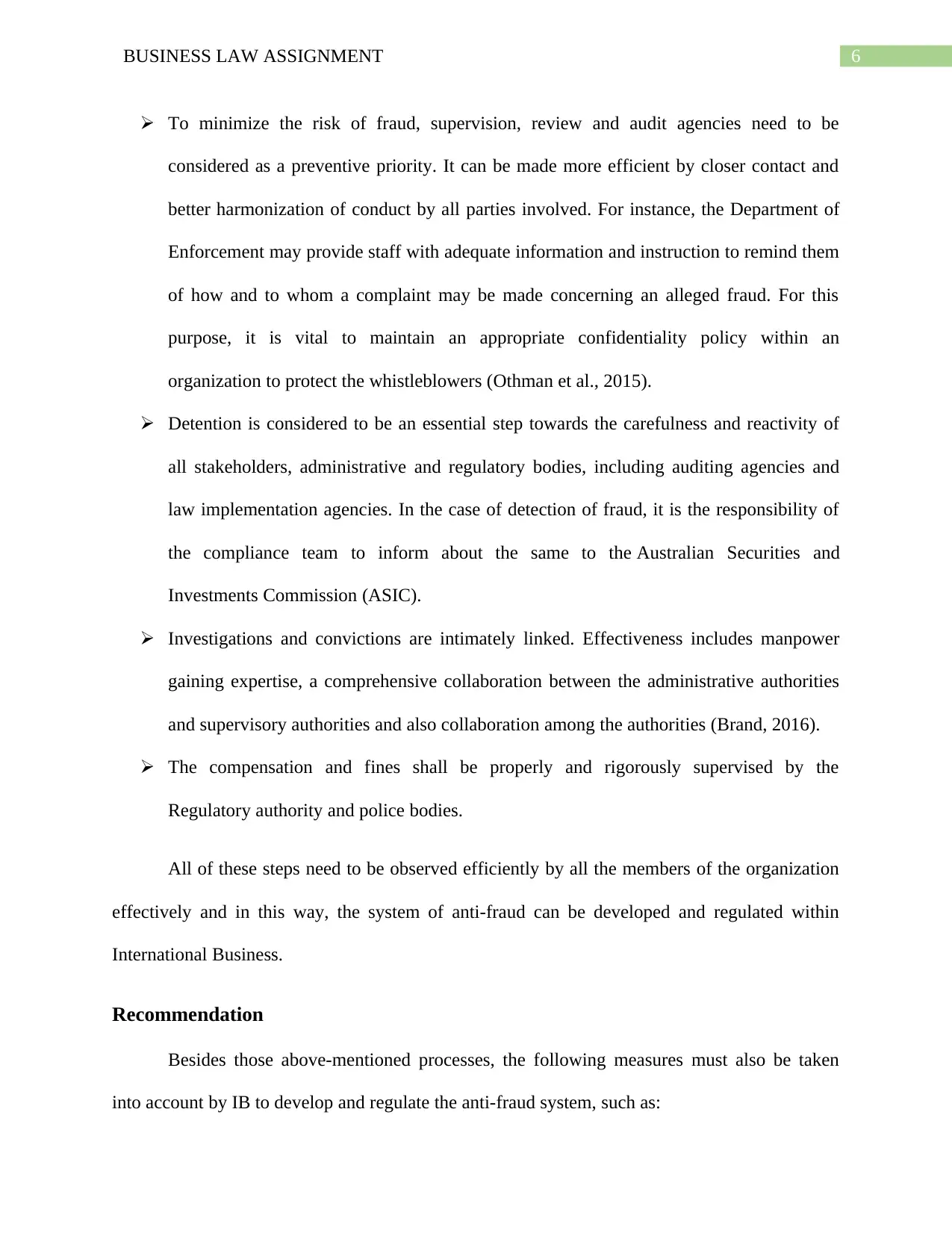
6BUSINESS LAW ASSIGNMENT
To minimize the risk of fraud, supervision, review and audit agencies need to be
considered as a preventive priority. It can be made more efficient by closer contact and
better harmonization of conduct by all parties involved. For instance, the Department of
Enforcement may provide staff with adequate information and instruction to remind them
of how and to whom a complaint may be made concerning an alleged fraud. For this
purpose, it is vital to maintain an appropriate confidentiality policy within an
organization to protect the whistleblowers (Othman et al., 2015).
Detention is considered to be an essential step towards the carefulness and reactivity of
all stakeholders, administrative and regulatory bodies, including auditing agencies and
law implementation agencies. In the case of detection of fraud, it is the responsibility of
the compliance team to inform about the same to the Australian Securities and
Investments Commission (ASIC).
Investigations and convictions are intimately linked. Effectiveness includes manpower
gaining expertise, a comprehensive collaboration between the administrative authorities
and supervisory authorities and also collaboration among the authorities (Brand, 2016).
The compensation and fines shall be properly and rigorously supervised by the
Regulatory authority and police bodies.
All of these steps need to be observed efficiently by all the members of the organization
effectively and in this way, the system of anti-fraud can be developed and regulated within
International Business.
Recommendation
Besides those above-mentioned processes, the following measures must also be taken
into account by IB to develop and regulate the anti-fraud system, such as:
To minimize the risk of fraud, supervision, review and audit agencies need to be
considered as a preventive priority. It can be made more efficient by closer contact and
better harmonization of conduct by all parties involved. For instance, the Department of
Enforcement may provide staff with adequate information and instruction to remind them
of how and to whom a complaint may be made concerning an alleged fraud. For this
purpose, it is vital to maintain an appropriate confidentiality policy within an
organization to protect the whistleblowers (Othman et al., 2015).
Detention is considered to be an essential step towards the carefulness and reactivity of
all stakeholders, administrative and regulatory bodies, including auditing agencies and
law implementation agencies. In the case of detection of fraud, it is the responsibility of
the compliance team to inform about the same to the Australian Securities and
Investments Commission (ASIC).
Investigations and convictions are intimately linked. Effectiveness includes manpower
gaining expertise, a comprehensive collaboration between the administrative authorities
and supervisory authorities and also collaboration among the authorities (Brand, 2016).
The compensation and fines shall be properly and rigorously supervised by the
Regulatory authority and police bodies.
All of these steps need to be observed efficiently by all the members of the organization
effectively and in this way, the system of anti-fraud can be developed and regulated within
International Business.
Recommendation
Besides those above-mentioned processes, the following measures must also be taken
into account by IB to develop and regulate the anti-fraud system, such as:
Paraphrase This Document
Need a fresh take? Get an instant paraphrase of this document with our AI Paraphraser
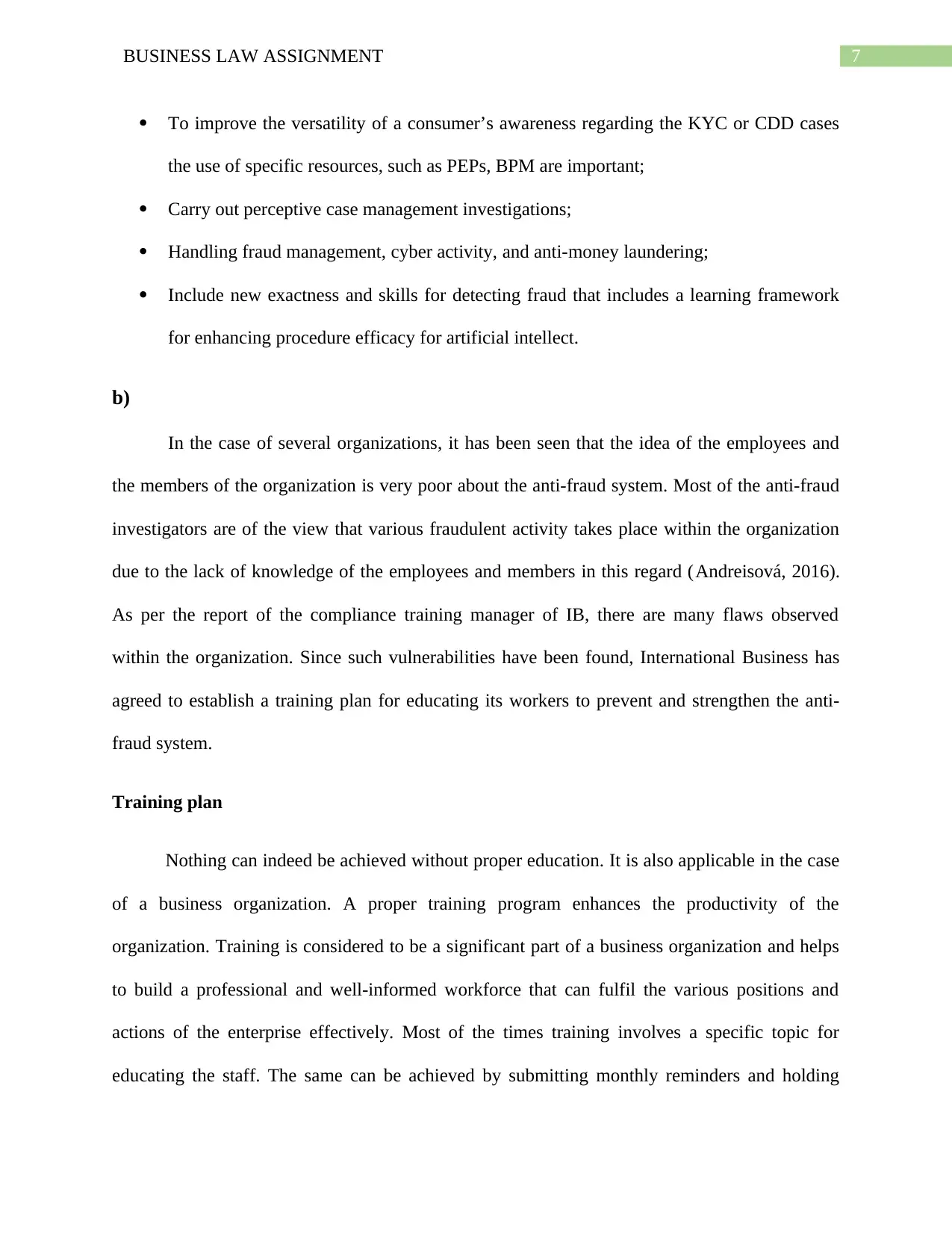
7BUSINESS LAW ASSIGNMENT
To improve the versatility of a consumer’s awareness regarding the KYC or CDD cases
the use of specific resources, such as PEPs, BPM are important;
Carry out perceptive case management investigations;
Handling fraud management, cyber activity, and anti-money laundering;
Include new exactness and skills for detecting fraud that includes a learning framework
for enhancing procedure efficacy for artificial intellect.
b)
In the case of several organizations, it has been seen that the idea of the employees and
the members of the organization is very poor about the anti-fraud system. Most of the anti-fraud
investigators are of the view that various fraudulent activity takes place within the organization
due to the lack of knowledge of the employees and members in this regard (Andreisová, 2016).
As per the report of the compliance training manager of IB, there are many flaws observed
within the organization. Since such vulnerabilities have been found, International Business has
agreed to establish a training plan for educating its workers to prevent and strengthen the anti-
fraud system.
Training plan
Nothing can indeed be achieved without proper education. It is also applicable in the case
of a business organization. A proper training program enhances the productivity of the
organization. Training is considered to be a significant part of a business organization and helps
to build a professional and well-informed workforce that can fulfil the various positions and
actions of the enterprise effectively. Most of the times training involves a specific topic for
educating the staff. The same can be achieved by submitting monthly reminders and holding
To improve the versatility of a consumer’s awareness regarding the KYC or CDD cases
the use of specific resources, such as PEPs, BPM are important;
Carry out perceptive case management investigations;
Handling fraud management, cyber activity, and anti-money laundering;
Include new exactness and skills for detecting fraud that includes a learning framework
for enhancing procedure efficacy for artificial intellect.
b)
In the case of several organizations, it has been seen that the idea of the employees and
the members of the organization is very poor about the anti-fraud system. Most of the anti-fraud
investigators are of the view that various fraudulent activity takes place within the organization
due to the lack of knowledge of the employees and members in this regard (Andreisová, 2016).
As per the report of the compliance training manager of IB, there are many flaws observed
within the organization. Since such vulnerabilities have been found, International Business has
agreed to establish a training plan for educating its workers to prevent and strengthen the anti-
fraud system.
Training plan
Nothing can indeed be achieved without proper education. It is also applicable in the case
of a business organization. A proper training program enhances the productivity of the
organization. Training is considered to be a significant part of a business organization and helps
to build a professional and well-informed workforce that can fulfil the various positions and
actions of the enterprise effectively. Most of the times training involves a specific topic for
educating the staff. The same can be achieved by submitting monthly reminders and holding
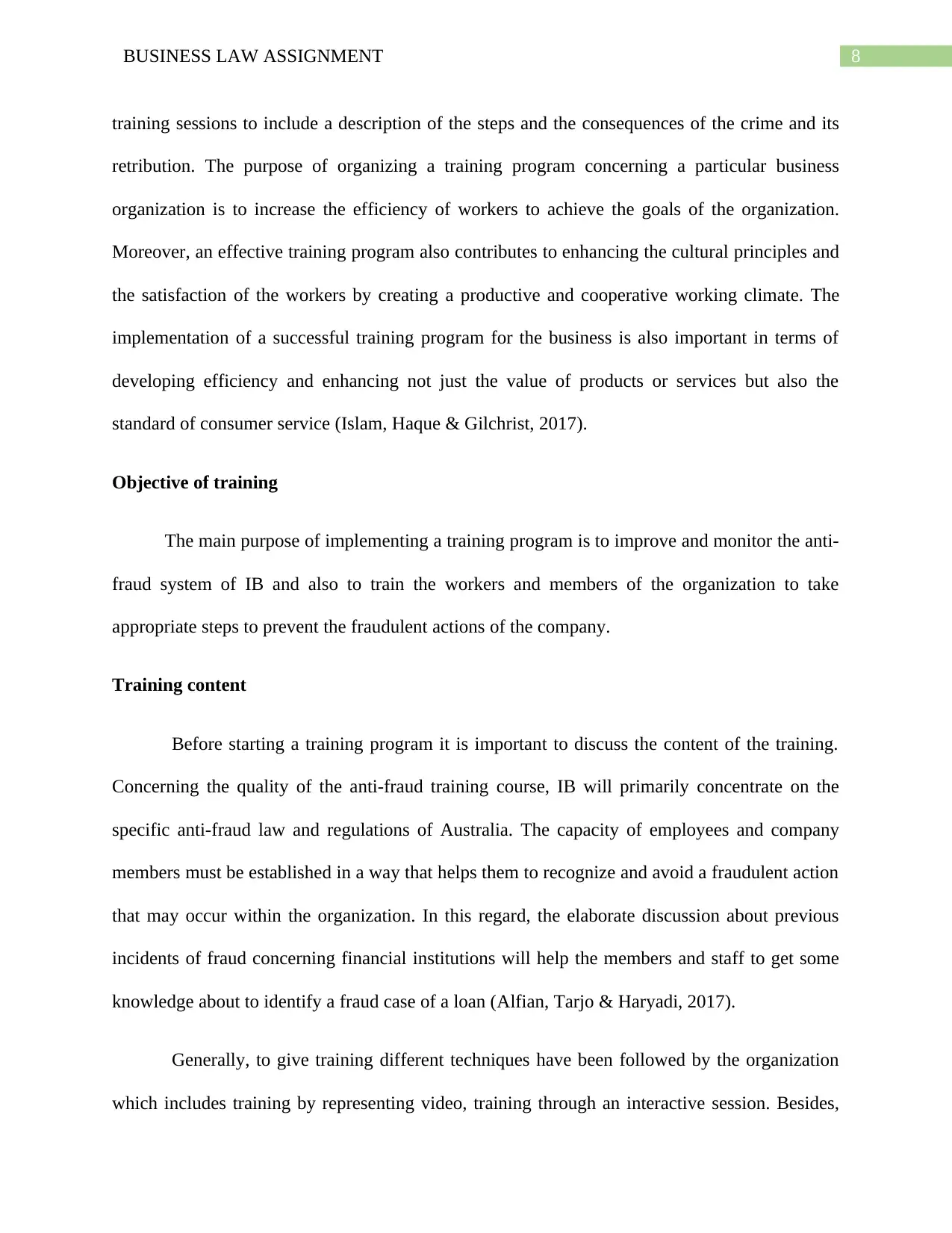
8BUSINESS LAW ASSIGNMENT
training sessions to include a description of the steps and the consequences of the crime and its
retribution. The purpose of organizing a training program concerning a particular business
organization is to increase the efficiency of workers to achieve the goals of the organization.
Moreover, an effective training program also contributes to enhancing the cultural principles and
the satisfaction of the workers by creating a productive and cooperative working climate. The
implementation of a successful training program for the business is also important in terms of
developing efficiency and enhancing not just the value of products or services but also the
standard of consumer service (Islam, Haque & Gilchrist, 2017).
Objective of training
The main purpose of implementing a training program is to improve and monitor the anti-
fraud system of IB and also to train the workers and members of the organization to take
appropriate steps to prevent the fraudulent actions of the company.
Training content
Before starting a training program it is important to discuss the content of the training.
Concerning the quality of the anti-fraud training course, IB will primarily concentrate on the
specific anti-fraud law and regulations of Australia. The capacity of employees and company
members must be established in a way that helps them to recognize and avoid a fraudulent action
that may occur within the organization. In this regard, the elaborate discussion about previous
incidents of fraud concerning financial institutions will help the members and staff to get some
knowledge about to identify a fraud case of a loan (Alfian, Tarjo & Haryadi, 2017).
Generally, to give training different techniques have been followed by the organization
which includes training by representing video, training through an interactive session. Besides,
training sessions to include a description of the steps and the consequences of the crime and its
retribution. The purpose of organizing a training program concerning a particular business
organization is to increase the efficiency of workers to achieve the goals of the organization.
Moreover, an effective training program also contributes to enhancing the cultural principles and
the satisfaction of the workers by creating a productive and cooperative working climate. The
implementation of a successful training program for the business is also important in terms of
developing efficiency and enhancing not just the value of products or services but also the
standard of consumer service (Islam, Haque & Gilchrist, 2017).
Objective of training
The main purpose of implementing a training program is to improve and monitor the anti-
fraud system of IB and also to train the workers and members of the organization to take
appropriate steps to prevent the fraudulent actions of the company.
Training content
Before starting a training program it is important to discuss the content of the training.
Concerning the quality of the anti-fraud training course, IB will primarily concentrate on the
specific anti-fraud law and regulations of Australia. The capacity of employees and company
members must be established in a way that helps them to recognize and avoid a fraudulent action
that may occur within the organization. In this regard, the elaborate discussion about previous
incidents of fraud concerning financial institutions will help the members and staff to get some
knowledge about to identify a fraud case of a loan (Alfian, Tarjo & Haryadi, 2017).
Generally, to give training different techniques have been followed by the organization
which includes training by representing video, training through an interactive session. Besides,
⊘ This is a preview!⊘
Do you want full access?
Subscribe today to unlock all pages.

Trusted by 1+ million students worldwide
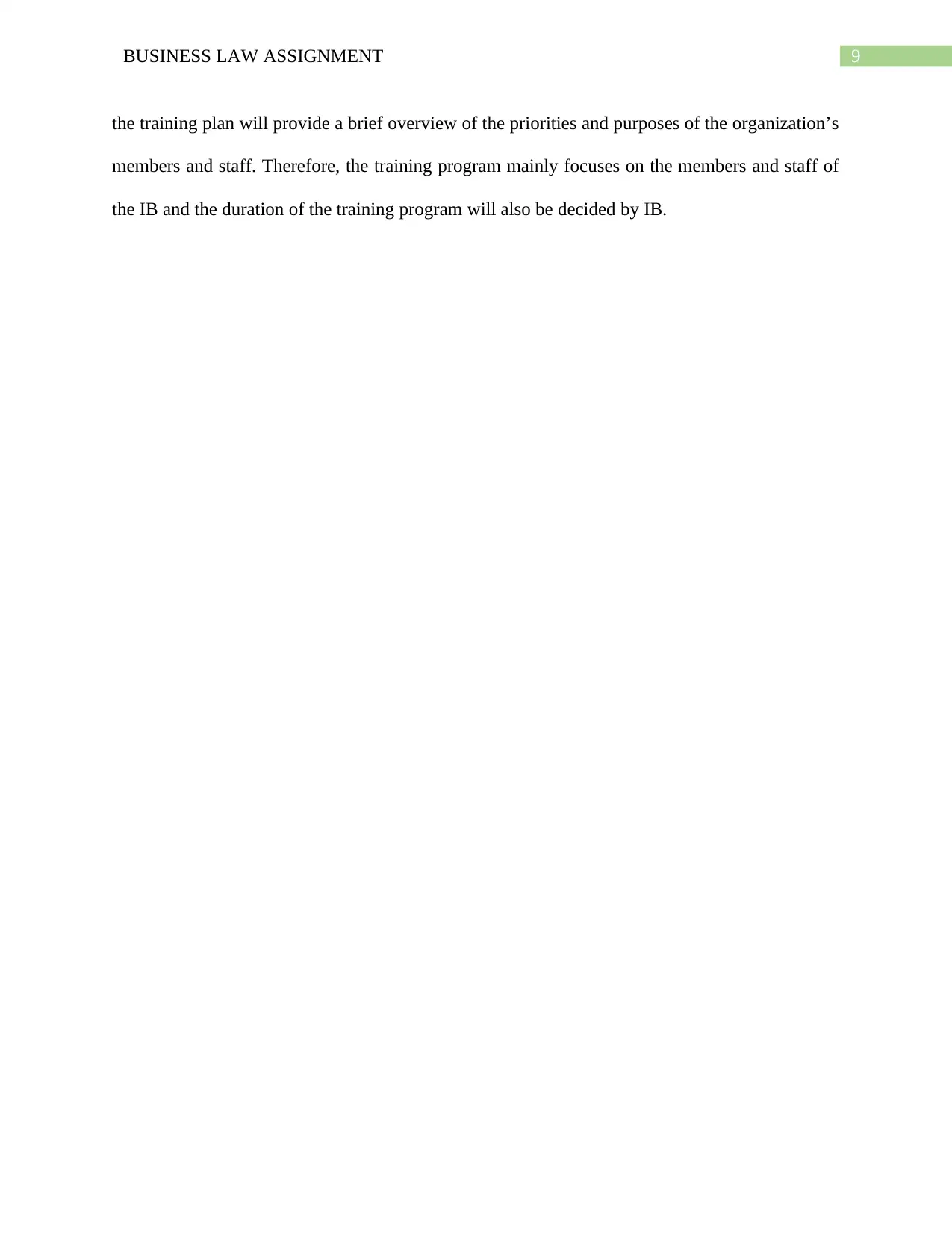
9BUSINESS LAW ASSIGNMENT
the training plan will provide a brief overview of the priorities and purposes of the organization’s
members and staff. Therefore, the training program mainly focuses on the members and staff of
the IB and the duration of the training program will also be decided by IB.
the training plan will provide a brief overview of the priorities and purposes of the organization’s
members and staff. Therefore, the training program mainly focuses on the members and staff of
the IB and the duration of the training program will also be decided by IB.
Paraphrase This Document
Need a fresh take? Get an instant paraphrase of this document with our AI Paraphraser
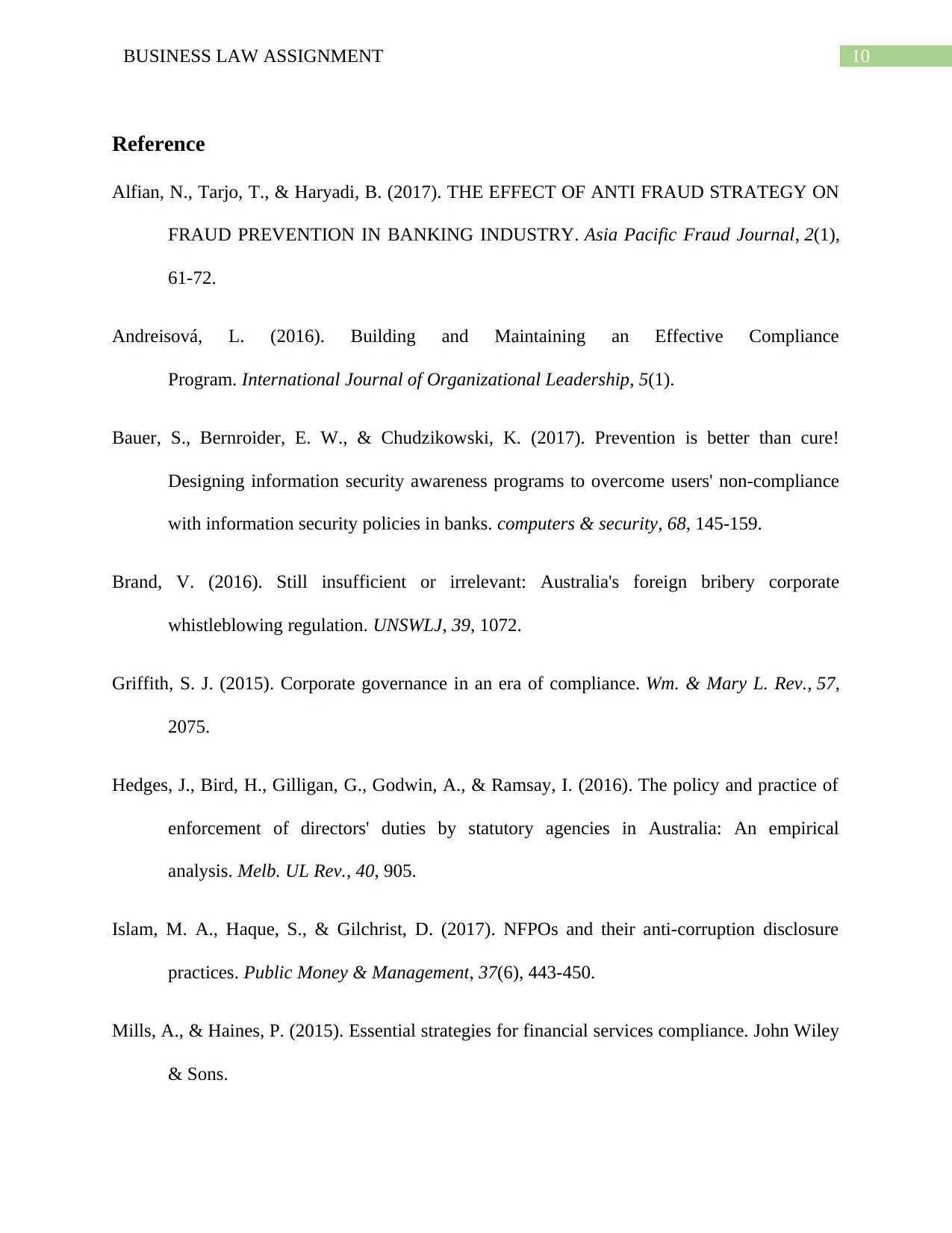
10BUSINESS LAW ASSIGNMENT
Reference
Alfian, N., Tarjo, T., & Haryadi, B. (2017). THE EFFECT OF ANTI FRAUD STRATEGY ON
FRAUD PREVENTION IN BANKING INDUSTRY. Asia Pacific Fraud Journal, 2(1),
61-72.
Andreisová, L. (2016). Building and Maintaining an Effective Compliance
Program. International Journal of Organizational Leadership, 5(1).
Bauer, S., Bernroider, E. W., & Chudzikowski, K. (2017). Prevention is better than cure!
Designing information security awareness programs to overcome users' non-compliance
with information security policies in banks. computers & security, 68, 145-159.
Brand, V. (2016). Still insufficient or irrelevant: Australia's foreign bribery corporate
whistleblowing regulation. UNSWLJ, 39, 1072.
Griffith, S. J. (2015). Corporate governance in an era of compliance. Wm. & Mary L. Rev., 57,
2075.
Hedges, J., Bird, H., Gilligan, G., Godwin, A., & Ramsay, I. (2016). The policy and practice of
enforcement of directors' duties by statutory agencies in Australia: An empirical
analysis. Melb. UL Rev., 40, 905.
Islam, M. A., Haque, S., & Gilchrist, D. (2017). NFPOs and their anti-corruption disclosure
practices. Public Money & Management, 37(6), 443-450.
Mills, A., & Haines, P. (2015). Essential strategies for financial services compliance. John Wiley
& Sons.
Reference
Alfian, N., Tarjo, T., & Haryadi, B. (2017). THE EFFECT OF ANTI FRAUD STRATEGY ON
FRAUD PREVENTION IN BANKING INDUSTRY. Asia Pacific Fraud Journal, 2(1),
61-72.
Andreisová, L. (2016). Building and Maintaining an Effective Compliance
Program. International Journal of Organizational Leadership, 5(1).
Bauer, S., Bernroider, E. W., & Chudzikowski, K. (2017). Prevention is better than cure!
Designing information security awareness programs to overcome users' non-compliance
with information security policies in banks. computers & security, 68, 145-159.
Brand, V. (2016). Still insufficient or irrelevant: Australia's foreign bribery corporate
whistleblowing regulation. UNSWLJ, 39, 1072.
Griffith, S. J. (2015). Corporate governance in an era of compliance. Wm. & Mary L. Rev., 57,
2075.
Hedges, J., Bird, H., Gilligan, G., Godwin, A., & Ramsay, I. (2016). The policy and practice of
enforcement of directors' duties by statutory agencies in Australia: An empirical
analysis. Melb. UL Rev., 40, 905.
Islam, M. A., Haque, S., & Gilchrist, D. (2017). NFPOs and their anti-corruption disclosure
practices. Public Money & Management, 37(6), 443-450.
Mills, A., & Haines, P. (2015). Essential strategies for financial services compliance. John Wiley
& Sons.
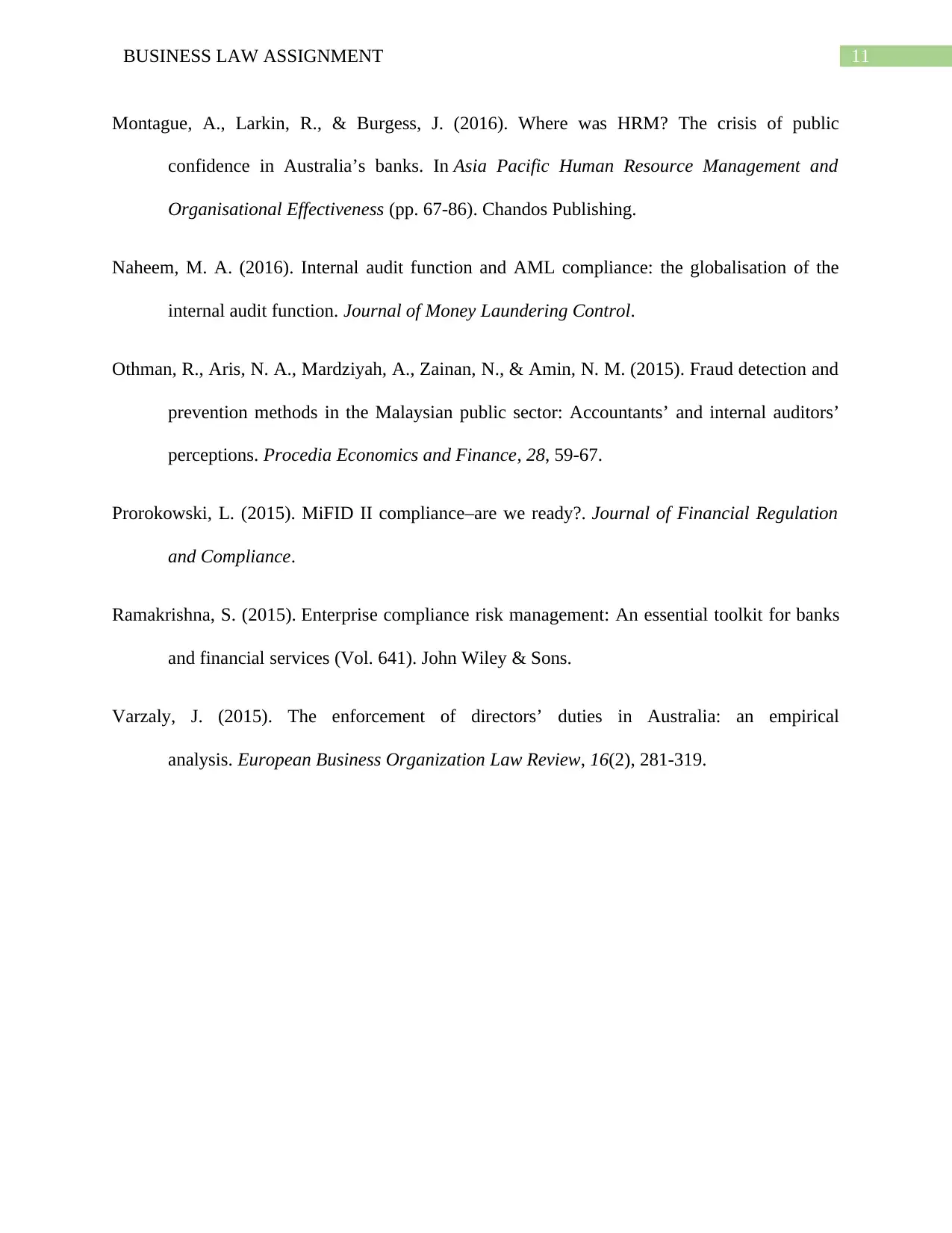
11BUSINESS LAW ASSIGNMENT
Montague, A., Larkin, R., & Burgess, J. (2016). Where was HRM? The crisis of public
confidence in Australia’s banks. In Asia Pacific Human Resource Management and
Organisational Effectiveness (pp. 67-86). Chandos Publishing.
Naheem, M. A. (2016). Internal audit function and AML compliance: the globalisation of the
internal audit function. Journal of Money Laundering Control.
Othman, R., Aris, N. A., Mardziyah, A., Zainan, N., & Amin, N. M. (2015). Fraud detection and
prevention methods in the Malaysian public sector: Accountants’ and internal auditors’
perceptions. Procedia Economics and Finance, 28, 59-67.
Prorokowski, L. (2015). MiFID II compliance–are we ready?. Journal of Financial Regulation
and Compliance.
Ramakrishna, S. (2015). Enterprise compliance risk management: An essential toolkit for banks
and financial services (Vol. 641). John Wiley & Sons.
Varzaly, J. (2015). The enforcement of directors’ duties in Australia: an empirical
analysis. European Business Organization Law Review, 16(2), 281-319.
Montague, A., Larkin, R., & Burgess, J. (2016). Where was HRM? The crisis of public
confidence in Australia’s banks. In Asia Pacific Human Resource Management and
Organisational Effectiveness (pp. 67-86). Chandos Publishing.
Naheem, M. A. (2016). Internal audit function and AML compliance: the globalisation of the
internal audit function. Journal of Money Laundering Control.
Othman, R., Aris, N. A., Mardziyah, A., Zainan, N., & Amin, N. M. (2015). Fraud detection and
prevention methods in the Malaysian public sector: Accountants’ and internal auditors’
perceptions. Procedia Economics and Finance, 28, 59-67.
Prorokowski, L. (2015). MiFID II compliance–are we ready?. Journal of Financial Regulation
and Compliance.
Ramakrishna, S. (2015). Enterprise compliance risk management: An essential toolkit for banks
and financial services (Vol. 641). John Wiley & Sons.
Varzaly, J. (2015). The enforcement of directors’ duties in Australia: an empirical
analysis. European Business Organization Law Review, 16(2), 281-319.
⊘ This is a preview!⊘
Do you want full access?
Subscribe today to unlock all pages.

Trusted by 1+ million students worldwide
1 out of 12
Related Documents
Your All-in-One AI-Powered Toolkit for Academic Success.
+13062052269
info@desklib.com
Available 24*7 on WhatsApp / Email
![[object Object]](/_next/static/media/star-bottom.7253800d.svg)
Unlock your academic potential
Copyright © 2020–2025 A2Z Services. All Rights Reserved. Developed and managed by ZUCOL.





